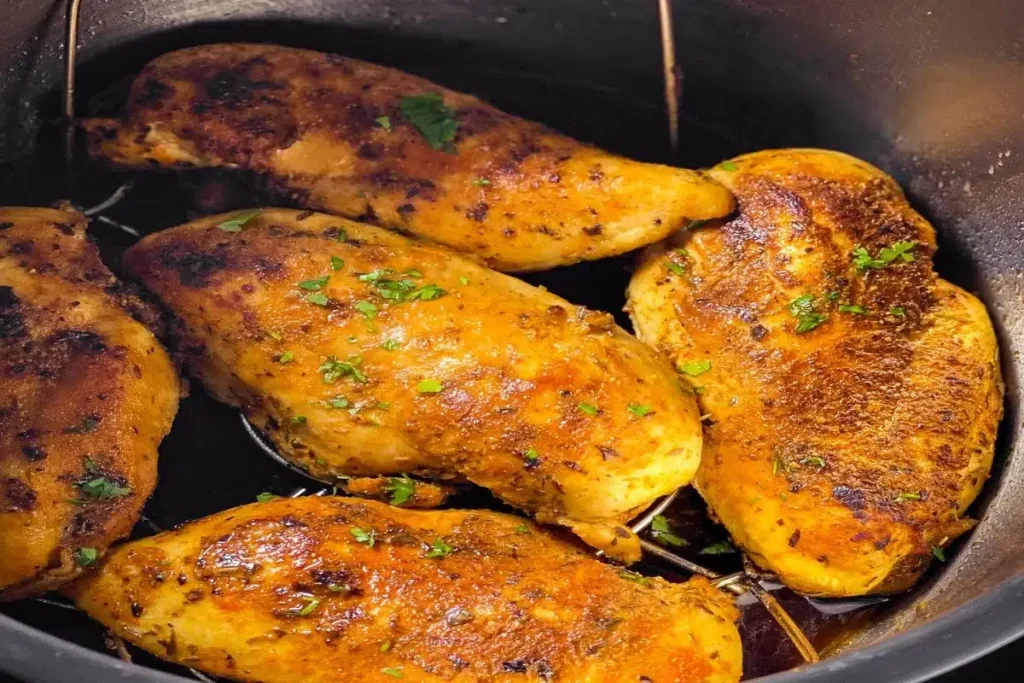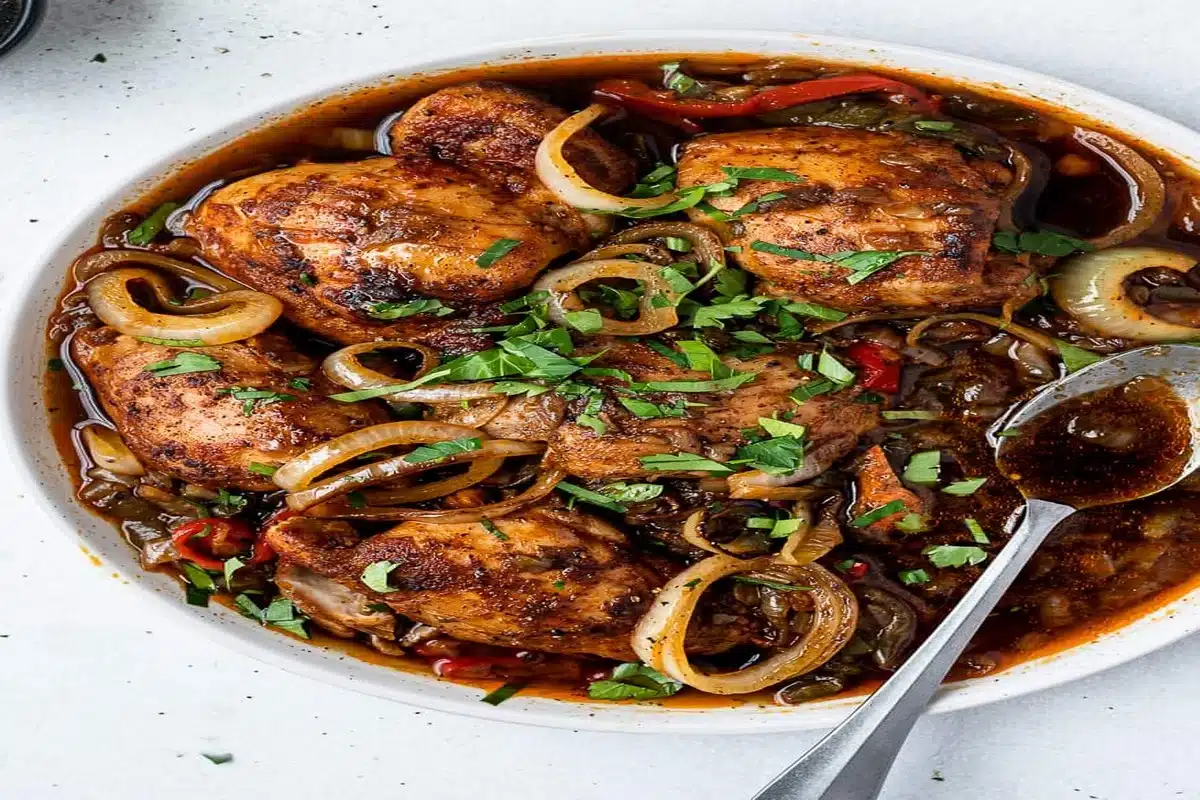Cooking chicken in an Instant Pot is supposed to make your life easier and the meals tastier. However, many people find themselves asking, “Why does my Instant Pot chicken taste rubbery?” There’s nothing more disappointing than biting into what should be a succulent piece of chicken, only to find it tough and rubbery instead. In this comprehensive guide, we’ll explore why this happens and, more importantly, how you can prevent it.
Common Reasons for Why does my Instant Pot chicken taste
Why does my Instant Pot chicken come out Rubbery Chicken? This is a frequent concern among Instant Pot users. There are several reasons your chicken might end up chewy and unpleasant, ranging from cooking time to the quality of the meat. Let’s break down the main culprits:
- Overcooking: One of the most common reasons for rubbery chicken is overcooking. The high pressure in an Instant Pot cooks food faster, but it’s easy to leave it in for too long. Overcooking results in the proteins tightening too much, leading to a tough, rubbery texture.
- Undercooking: Ironically, undercooked chicken can also feel rubbery. When the chicken isn’t cooked long enough, the proteins haven’t had a chance to break down properly, resulting in a chewy texture. Make sure to use a meat thermometer to ensure the internal temperature reaches 165°F (74°C).
- Chicken Quality: The quality of the chicken you use matters. Cheap, mass-produced chicken often lacks the tenderness of higher-quality, organic options. If possible, opt for chicken that is free-range and hormone-free for the best results.
Here is a guide from FoodSafety.gov that can help you with recommended cooking temperatures for various types of meat, including chicken.
Another helpful resource on cooking chicken in pressure cookers from The Kitchn provides tips on avoiding common pitfalls.
PrintWhy Does My Instant Pot Chicken Taste Rubbery?
- Total Time: 30 minutes
- Yield: 2 servings 1x
Description
This Rubbery Instant Pot Chicken recipe yields tender, juicy meat when done right—but here’s a version that often results in rubbery chicken, so you know what not to do.
Ingredients
1 lb boneless, skinless chicken breasts
1 cup water
1/2 tsp salt
1/2 tsp black pepper
Instructions
1. Place the chicken breasts directly into the Instant Pot.
2. Add 1 cup of water along with salt and pepper.
3. Seal the lid and set the Instant Pot to Manual or Pressure Cook on High for 15 minutes.
4. Let the pressure release naturally for 10 minutes, then do a quick release.
5. Remove the chicken and check for doneness. Chicken may be rubbery due to overcooking or lack of seasoning.
Notes
Cooking chicken breasts for too long under pressure, especially without proper seasoning or fat, can lead to a rubbery texture.
For better results, try using chicken thighs or shortening the cook time to 8-10 minutes.
Always allow at least a partial natural pressure release to retain moisture.
- Prep Time: 5 minutes
- Cook Time: 15 minutes
- Category: Main
- Method: Pressure Cooking
- Cuisine: American
Nutrition
- Serving Size: 1 chicken breast
- Calories: 165
- Sugar: 0g
- Sodium: 320mg
- Fat: 3.5g
- Saturated Fat: 1g
- Unsaturated Fat: 2g
- Trans Fat: 0g
- Carbohydrates: 0g
- Fiber: 0g
- Protein: 31g
- Cholesterol: 85mg
Keywords: instant pot chicken, rubbery chicken, pressure cooker mistakes
Tips to Prevent Why does my Instant Pot chicken taste
If you’re tired of asking yourself, “Why does my chicken taste rubbery when I cook it in the Instant Pot?”, don’t worry. There are plenty of strategies to improve the tenderness and taste of your chicken.
1. Use the Right Cut of Chicken
Different cuts of Rubbery Chicken yield different results in the Instant Pot. If you’re using chicken breast, keep in mind that it has very little fat compared to thighs, which makes it more prone to drying out and becoming rubbery.
- Chicken Thighs: These are generally more forgiving because they contain more fat, which keeps them juicy during cooking.
- Bone-In Cuts: Using bone-in chicken can also help retain moisture and improve flavor.
2. Adjust the Cooking Time
Timing is crucial when cooking chicken in an Instant Pot. The Instant Pot works by building pressure, which cooks the food faster. Therefore, the timing should be adjusted carefully to avoid overcooking.
- Boneless Chicken Breast: Cook for 6-8 minutes on high pressure, with a quick release.
- Bone-In Thighs: Cook for 10-12 minutes under high pressure, with a natural release of about 5 minutes before venting.
Always allow for natural release when possible. This helps keep the chicken tender by slowly reducing the pressure.
3. Use Liquid and Avoid Dry Cooking
The Instant Pot relies on steam to cook food effectively. Not using enough liquid can lead to dry, rubbery chicken.
- Add at least 1 cup of chicken broth or water when cooking chicken. This will ensure there’s enough steam to keep the chicken juicy.
- For extra flavor, consider adding aromatics like garlic, onion, and herbs.
Marinating Your Chicken for Extra Tenderness Rubbery Chicken
Marinating the Rubbery Chicken before cooking can significantly help with tenderness. A good marinade contains three essential components:
- Acid: Vinegar, lemon juice, or yogurt can help break down proteins, making the chicken more tender.
- Oil: Olive oil or any other fat helps retain moisture during the cooking process.
- Seasoning: Garlic, herbs, salt, and pepper add flavor to the chicken, making it more enjoyable.
Marinate the chicken for at least 30 minutes before cooking. If time allows, overnight marination can yield even better results.
Avoiding the “Chewy Chicken” Problem Rubbery Chicken
What makes the chicken chewy in the Instant Pot? This is often due to insufficient resting time. When the chicken is cooked, the proteins are very tight. Letting the chicken rest for 5-10 minutes after cooking allows the juices to redistribute, making the meat more tender.
In addition, be sure not to slice the chicken immediately after cooking. Cutting too soon can cause the juices to escape, leading to a dry and rubbery texture. Always let it rest under a loose foil cover before slicing.
Cooking with Different Methods in the Rubbery Instant Pot Chicken
Your Instant Pot offers different cooking settings that can affect the texture of your Rubbery Chicken:
- Pressure Cook Setting: This is the default for most chicken recipes. It works well for both quick and thorough cooking but can lead to a rubbery texture if overcooked.
- Saute Setting: Use this setting to sear the chicken before pressure cooking. This helps lock in moisture and adds flavor.
- Slow Cook Setting: If you have time, slow cooking chicken in the Instant Pot can yield very tender and juicy meat. This is an excellent option if you find pressure cooking results too inconsistent.
How to Season Chicken for Maximum Flavor Rubbery Instant Pot Chicken
Seasoning plays a key role in avoiding bland, rubbery chicken. Before cooking, generously season the chicken with salt, pepper, and any preferred spices. The pressure cooking process can dilute flavors, so it’s essential to season well.
- Salt: Helps break down proteins, contributing to tenderness.
- Herbs and Spices: Paprika, thyme, rosemary, and garlic powder are all excellent options.
Consider making a seasoning blend specifically for Instant Pot cooking. Remember, Instant Pot cooking requires a stronger seasoning to ensure that flavors hold up.
The Importance of Resting Chicken After Cooking

One critical step that is often overlooked is resting the chicken after it’s been cooked in the Instant Pot. When the chicken is under pressure, its proteins are under tension. Resting helps the chicken relax and allows the juices to redistribute throughout the meat. This simple but essential step can make a significant difference in the final texture of the chicken.
When you release the pressure, carefully remove the chicken and place it on a cutting board. Cover loosely with foil and let it rest for about 5-10 minutes. This waiting period may seem inconvenient, but it’s key to avoiding dryness and rubberizes.
Cooking Frozen in the Instant Pot Rubbery Instant Pot Chicken
One of the great advantages of the Instant Pot is that it can cook chicken directly from frozen. However, cooking frozen Rubbery Chicken poses some challenges in terms of achieving the perfect texture. Here are some tips to ensure your frozen chicken doesn’t come out rubbery:
- Increase Cooking Time: Frozen chicken needs more time under pressure. For boneless frozen chicken breasts, cook for 10-12 minutes on high pressure, followed by a natural release for 10 minutes.
- Add Liquid: Use at least 1.5 cups of broth or water when cooking from frozen to ensure there is enough steam for proper cooking.
- Avoid Quick Release: Always use natural release when cooking frozen chicken. This allows the proteins to relax gradually, resulting in a more tender texture.
The Role of Pressure Release Methods Rubbery Chicken
How you release the pressure after cooking plays an essential role in the texture of your chicken. There are two main types of pressure release: Quick Release (QR) and Natural Pressure Release (NPR). Each has its purpose, but for chicken, NPR is usually the better option to avoid rubberizes.
- Natural Pressure Release: This method lets the pressure drop slowly, which allows the chicken’s juices to redistribute evenly. This helps in keeping the chicken moist and tender.
- Quick Release: While this method is faster, it can often lead to tougher meat because the rapid drop in pressure causes the juices to rush out of the chicken.
If you’re in a hurry, consider doing a combination of both methods—let the pressure release naturally for 5 minutes, then finish with a quick release.
How Brining Can Improve Chicken Texture
Brining is a technique used to enhance the tenderness and flavor of the Rubbery Chicken before cooking. The process involves soaking the chicken in a saltwater solution for several hours, which helps the meat retain moisture and season it thoroughly.
- Basic Brine Recipe: Mix 1/4 cup of salt with 4 cups of water. Add any herbs or spices you like. Submerge the chicken in the brine and refrigerate for at least 1-2 hours.
- Benefits of Brining: The salt in the brine breaks down the muscle fibers, which helps in reducing toughness and prevents the chicken from becoming rubbery.
Brining can be especially helpful if you’re cooking chicken breast, which tends to dry out easily.
Choosing Between High and Low-Pressure Settings Rubbery Chicken
Your Instant Pot comes with high and low-pressure settings, both of which can be used to cook chicken. The choice of setting can significantly affect the texture of your chicken.
- High Pressure: This setting is faster and cooks the chicken more quickly. It’s great for bone-in cuts or when you need to cook in a shorter period.
- Low Pressure: This setting cooks the chicken more gently, which can result in a juicier and more tender texture, especially for boneless chicken breast.
Experiment with both settings to see which one gives you the desired texture. For most tender results, low pressure is often recommended when cooking leaner cuts.
Using a Meat Thermometer for Perfect Results Rubbery Chicken
A meat thermometer is one of the best tools you can use to ensure your chicken isn’t rubbery. Instant Pot cooking can sometimes be inconsistent due to factors like chicken thickness, starting temperature, and even the model of Instant Pot you have.
- Check Internal Temperature: The chicken should reach an internal temperature of 165°F (74°C). Measuring this ensures that it’s cooked through but not overdone.
- Measure at the Thickest Part: Insert the thermometer into the thickest part of the chicken, avoiding bones. This guarantees accurate readings and helps avoid both undercooked and overcooked results.
Slow Cook vs. Pressure Cook: Which is Better for Tender Chicken?
The Instant Pot can function as both a pressure cooker and a slow cooker, and each method has its advantages for cooking chicken.
- Pressure Cooking: This method is ideal for quick meals. It uses high pressure to cook chicken in a fraction of the time it would take using other methods. However, the margin for error is smaller, and overcooking can happen quickly, resulting in rubbery chicken.
- Slow Cooking: This method is perfect for achieving fall-off-the-bone tenderness. It’s much more forgiving, and the extended cooking time allows the collagen in the chicken to break down fully, resulting in tender, juicy meat.
For best results, if time allows, slow cooking can be the preferred method for making sure your chicken is tender and flavorful.
Adding Fat for Moisture Retention Rubbery Chicken
Adding a bit of fat can go a long way in ensuring that your chicken comes out tender and not rubbery. Fat helps to lock in moisture, making the final result juicy and flavorful.
- Butter or Oil: Adding a tablespoon of butter or oil when cooking chicken can significantly enhance its texture.
- Chicken Skin: If cooking chicken thighs or drumsticks, leave the skin on. The fat from the skin is rendered out during cooking and keeps the meat moist.
This is particularly important if you’re cooking chicken breast, which is very lean and tends to dry out more easily.
Enhancing Flavor with Aromatics Rubbery Chicken
Using aromatics like onions, garlic, and herbs can add incredible flavor to your chicken. These ingredients not only make your chicken taste better but can also contribute to a better texture by creating a more flavorful steam environment.
- Garlic and Onion: Chop these finely and add them to the liquid in the Instant Pot. As they cook, they release their flavor into the steam, which then penetrates the chicken.
- Herbs: Fresh herbs like thyme, rosemary, and parsley can elevate the flavor profile and make your chicken taste gourmet.
Adding aromatics also means you’re cooking in a more flavorful environment, which prevents the chicken from tasting bland.
Using Broth Instead of Water Rubbery Chicken
While you can cook chicken in plain water, using chicken broth or vegetable broth will make a significant difference in the final taste and tenderness of your chicken. The broth adds flavor and helps keep the chicken moist.
- Chicken Broth: Use about 1 cup of broth for every pound of chicken. This will provide a rich base that helps the chicken retain moisture.
- Bouillon: If you don’t have broth on hand, a bouillon cube dissolved in water is a good substitute.
The added flavor from the broth can help mask any potential rubbery texture by making the chicken taste richer and more flavorful.
Avoiding Overcrowding the Instant Pot chicken
Overcrowding the Instant Pot can lead to uneven cooking, which can cause some pieces to be undercooked and others overcooked. This imbalance can easily lead to a rubbery texture.
- Cook in Batches: If you’re cooking a lot of chicken, consider doing it in batches to avoid overcrowding.
- Layering: Place larger pieces at the bottom and smaller pieces on top. This way, the pieces will cook more evenly.
By giving each piece of chicken enough space, you allow the steam to circulate evenly, resulting in a more consistent and tender texture.
Serving Suggestions for Instant Pot Chicken
To make your Instant Pot chicken more enjoyable, consider pairing it with complementary sides that enhance the overall meal experience.
- Mashed Potatoes: Creamy mashed potatoes pair perfectly with juicy chicken and can soak up the flavorful juices.
- Steamed Vegetables: Broccoli, carrots, or green beans provide a crisp, fresh contrast to the tender chicken.
- Rice or Quinoa: Cooking grains like rice or quinoa in the Instant Pot along with the chicken can absorb the flavors and make for a complete meal.
Adding sides not only balances the texture but also ensures a variety of flavors in each bite.
Frequently Asked Questions Rubbery Chicken
Why Does My Instant Pot Chicken Come Out Rubbery?
The main reasons include overcooking or undercooking, not using enough liquid, or choosing the wrong cut of chicken. Lean chicken breast tends to dry out quickly, whereas thighs are more forgiving.
What Makes the Chicken Chewy in the Instant Pot?
Chewy chicken is often a result of not cooking the meat for long enough. It’s essential to ensure that the chicken reaches an internal temperature of 165°F. In addition, letting the chicken rest after cooking allows the proteins to relax, resulting in a less chewy texture.
Why Does My Chicken Taste Rubbery When I Cook It?
The rubbery taste can also come from overcooking, especially with chicken breast, or not adding enough moisture during the cooking process. Using a natural pressure release instead of a quick release can also help prevent this issue.
How Do You Keep Chicken from Tasting Rubbery?
- Use a meat thermometer to avoid overcooking.
- Marinate your chicken before cooking.
- Use bone-in, skin-on thighs for juicier results.
- Let the chicken rest before slicing to retain juices.
Conclusion
If you find yourself asking, “Why does my Instant Pot chicken taste rubbery?”, don’t despair. By choosing the right cut of chicken, adjusting your cooking time, adding sufficient liquid, and letting the chicken rest after cooking, you can ensure a tender and flavorful result every time.
Experiment with different cuts, marinate your meat and be sure to monitor cooking times carefully. With these adjustments, your Instant Pot Rubbery Chicken will no longer disappoint.
Looking for inspiration? Try our favorite mini cookies recipe here!

